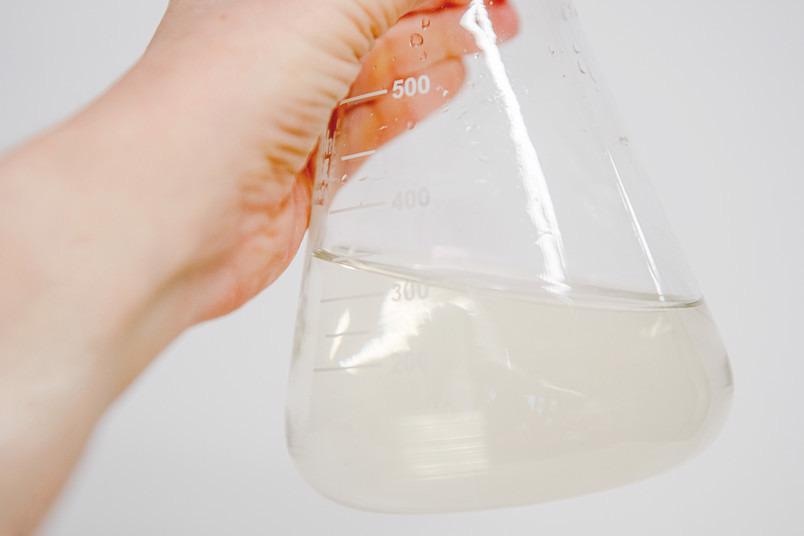Nov 23 2020
At present, it is simple to identify an average pH for huge quantities of liquid. However, it is difficult to specify a local pH value.
 What is the pH value of an aqueous solution? This question is not easily answered on the molecular level. Image Credit: RUB, Marquard.
What is the pH value of an aqueous solution? This question is not easily answered on the molecular level. Image Credit: RUB, Marquard.
At Ruhr-Universität Bochum, scientists have devised a new technique to identify a local pH value next to a particular site of a biomolecule. A pH meter has been used to make a reliable measurement only in a larger ensemble, or homogeneous bulk.
The latest procedure, which depends on terahertz spectroscopy, has been explained by the team from the Cluster of Excellence Ruhr Explores Solvation, Resolv for short, in a paper published online in the Angewandte Chemie International Edition journal, on November 6th, 2020.
The groups from the Chair of Physical Chemistry II under the guidance of Professor Martina Havenith and from the Chair of Theoretical Chemistry led by Professor Dominik Marx collaborated during the study.
There is increased evidence that biological reactions do not depend so much on the global chemical properties of a solution but rather that the local conditions in the immediate vicinity of an enzyme are crucial.
Dr Martina Havenith, Professor and Chair, Physical Chemistry II, Faculty of Chemistry and Biochemistry, Ruhr-Universität Bochum
This includes, for instance, the pH value or local charge state.
It is important for us to be able to not only measure these local properties but also to compute predictively—for instance, if we want to optimize solvation conditions for using enzymes as biocatalysts.
Dominik Marx, Professor and Chair of Theoretical Chemistry, Faculty of Chemistry and Biochemistry, Ruhr-Universität Bochum
Tests with the Amino Acid Glycine
The researchers worked with an amino acid glycine solution. It contains two functional groups that have the ability to collect or release protons. Thus, the acid can exist in different protonation states, which can be modified by adjusting the pH of the solution.
The chemists analyzed glycine solutions by making use of terahertz (THz) spectroscopy. They used transmit radiation in the THz frequency in the solution, which absorbs part of the radiation.
The team presented the absorption pattern in a specified frequency range in the form of a spectrum. Simultaneously, they also simulated the THz spectra of such aqueous solutions for various pH conditions.
Different Spectra Based on pH Value
The spectra varied considerably based on glycine’s protonation state. The two groups examined why this was so, with the help of complex computer simulations, known as ab initio molecular dynamics simulations.
This technique enables scientists to allocate a few areas of a spectrum—known as bands—to the movements of various bonds in the molecule. Thus, they demonstrated how the different protonation states were reflected in the spectrum.
Deprotonated glycine (high pH) results in virtually zero absorption in this part of the terahertz spectrum, but protonated glycine (low pH) generates visible absorption bands. The spectrum of an intermediate state, the glycine zwitterion (neutral pH), falls in between.
Therefore, the team achieved a kind of fingerprint of protonation, quantified as a function of pH. They demonstrated that the spectrum’s intensity in the range of 0 to 15 THz correlated with the pH.
In additional experiments, the team illustrated that the technique also works for other biomolecules, that is, the amino acid valine and for small peptides.
In the future, this fundamental finding will open up new opportunities for us to non-invasively determine local states of charge on the surface of biomolecules.
Dr Martina Havenith, Professor and Chair, Physical Chemistry II, Faculty of Chemistry and Biochemistry, Ruhr-Universität Bochum
The study was financially supported by the German Research Foundation as part of the Cluster of Excellence Resolv (EXC 2033 – 390677874) and the project with funding code MA 1547/11, as well as by the European Research Council as part of the project “THz-Calorimetry,” grant number 695437.
Journal Reference:
Havenith-Newen, M., et al. (2020) Probing local electrostatics of glycine in aqueous solution by THz spectroscopy. Angewandte Chemie International Edition. doi.org/10.1002/anie.202014133.